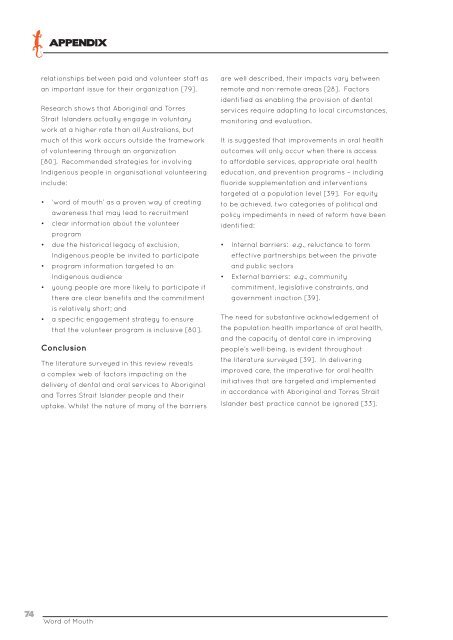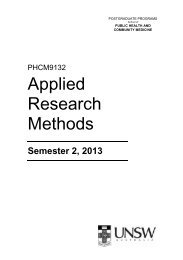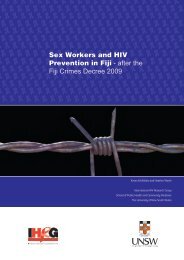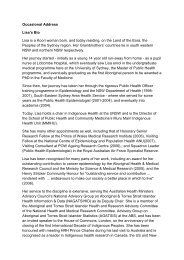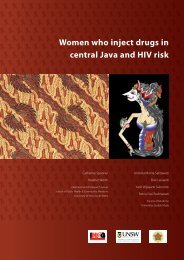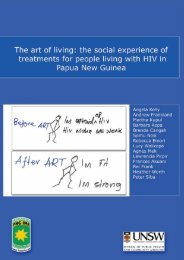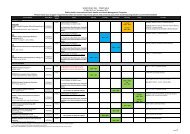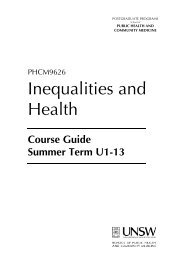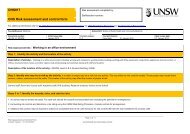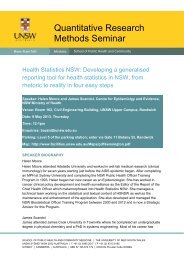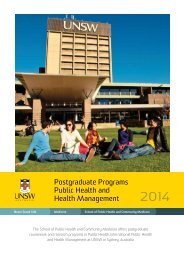Word of Mouth - School of Public Health and Community Medicine ...
Word of Mouth - School of Public Health and Community Medicine ...
Word of Mouth - School of Public Health and Community Medicine ...
- No tags were found...
Create successful ePaper yourself
Turn your PDF publications into a flip-book with our unique Google optimized e-Paper software.
APPENDIXrelationships between paid <strong>and</strong> volunteer staff asan important issue for their organization [79].Research shows that Aboriginal <strong>and</strong> TorresStrait Isl<strong>and</strong>ers actually engage in voluntarywork at a higher rate than all Australians, butmuch <strong>of</strong> this work occurs outside the framework<strong>of</strong> volunteering through an organization[80]. Recommended strategies for involvingIndigenous people in organisational volunteeringinclude:• ‘word <strong>of</strong> mouth’ as a proven way <strong>of</strong> creatingawareness that may lead to recruitment• clear information about the volunteerprogram• due the historical legacy <strong>of</strong> exclusion,Indigenous people be invited to participate• program information targeted to anIndigenous audience• young people are more likely to participate ifthere are clear benefits <strong>and</strong> the commitmentis relatively short; <strong>and</strong>• a specific engagement strategy to ensurethat the volunteer program is inclusive [80].ConclusionThe literature surveyed in this review revealsa complex web <strong>of</strong> factors impacting on thedelivery <strong>of</strong> dental <strong>and</strong> oral services to Aboriginal<strong>and</strong> Torres Strait Isl<strong>and</strong>er people <strong>and</strong> theiruptake. Whilst the nature <strong>of</strong> many <strong>of</strong> the barriersare well described, their impacts vary betweenremote <strong>and</strong> non-remote areas [28]. Factorsidentified as enabling the provision <strong>of</strong> dentalservices require adapting to local circumstances,monitoring <strong>and</strong> evaluation.It is suggested that improvements in oral healthoutcomes will only occur when there is accessto affordable services, appropriate oral healtheducation, <strong>and</strong> prevention programs – includingfluoride supplementation <strong>and</strong> interventionstargeted at a population level [39]. For equityto be achieved, two categories <strong>of</strong> political <strong>and</strong>policy impediments in need <strong>of</strong> reform have beenidentified:• Internal barriers: e.g., reluctance to formeffective partnerships between the private<strong>and</strong> public sectors• External barriers: e.g., communitycommitment, legislative constraints, <strong>and</strong>government inaction [39].The need for substantive acknowledgement <strong>of</strong>the population health importance <strong>of</strong> oral health,<strong>and</strong> the capacity <strong>of</strong> dental care in improvingpeople’s well-being, is evident throughoutthe literature surveyed [39]. In deliveringimproved care, the imperative for oral healthinitiatives that are targeted <strong>and</strong> implementedin accordance with Aboriginal <strong>and</strong> Torres StraitIsl<strong>and</strong>er best practice cannot be ignored [33].74<strong>Word</strong> <strong>of</strong> <strong>Mouth</strong>


